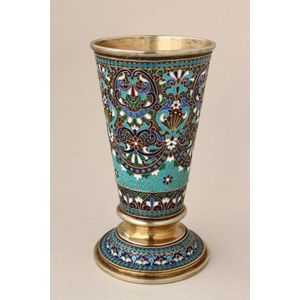Doulton Burslem Blue Floral Vase with Gold Gilt Highlights
You must be a subscriber, and be logged in to view price and dealer details.
Subscribe Now to view actual auction price for this item
When you subscribe, you have the option of setting the currency in which to display prices to $Au, $US, $NZ or Stg.
- Bone China - Bone china, Also called 'English china", is one of the three types of porcelain, the other two being soft paste porcelain and hard paste porcelain.
Porcelain is an ancient ceramic material, first made in China, hence the common name "china", and the introduction of bone china was to counter the imports of Chinese porcelain.
The initial development of bone china is credited to Josiah Spode, who introduced it around 1800 and it was soon after copied by other manufacturers including Minton, Coalport, Davenport, Derby, Worcester, Wedgwood and Rockingham and the Herculaneum factory at Liverpool.
Spode's bone china was made by mixing ash from cattle bones with feldspar and kaolin, which created a material that was stronger, more translucent, and whiter than traditional porcelain. He began to produce this new type of porcelain in 1796 and it quickly became very popular.
At the time, the process and ingredients were kept secret and were only known to a few manufacturers and were protected by patents.
In the 19th century, bone china became increasingly popular and was widely produced by many manufacturers in England. During this time, it was considered a luxury item and was often used to create fine dining sets and other decorative items.
Bone china is still used in the production of fine porcelain wares, such as tea sets, figurines, and other decorative pieces. His basic formula of six parts bone ash, four parts china stone, and three and a half parts china clay remains the standard English body. It is still considered a luxury item due to its strength, translucency, and whiteness, and is often used for high-end and high-quality porcelain. China. - A/f, as Inspected - The letters "A/F" or "as inspected" as part of a description is the cataloguer's shorthand for "all faults" or "as found", meaning the item has some type of damage or deficiency, it is of uncertain date or provenance, and/or that the seller takes no responsibility for the completeness of the item or the accuracy of the description.
This item has been included into following indexes:
- Royal Doulton (England) Series Ware - Floral 272
-
Royal Doulton (England), item types
- Burslem 388
- ovoid and baluster shaped vases 1,515
Visually similar items

Good Russian silver and enamel pedestal beaker, of tapering form, decorated with flower heads, stylised foliage and beading, on stepped circular foot, in tones of blue, white, red and green, gilt interior, impressed 84, B.A (possibly Vasily Akimov), total

Russian enamel vase, of tapering form, decorated with raised enamel work in the form of flowers in tones of red, white and blue, height 9.4 cm

A Danish silver beaker, 93g, 10 cm high

A Doulton Lambeth stoneware vase, circa 1887, by Hannah and Florence Barlow, incised Doulton Lambeth 1887, monogrammed Florence and Hannah Barlow, 45 cm high
